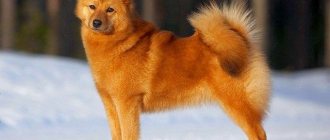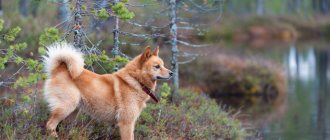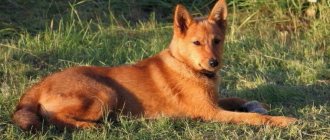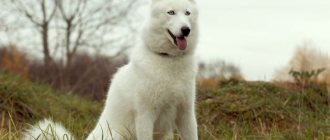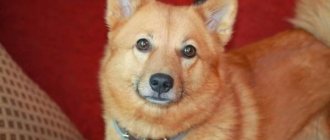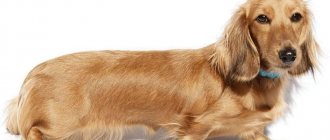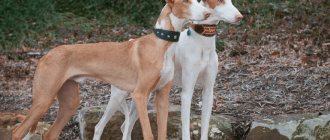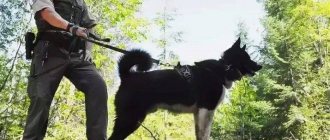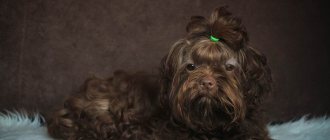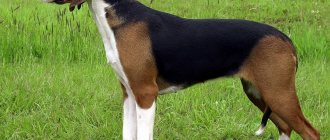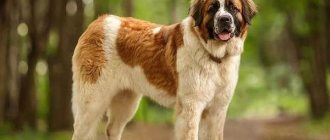The Karelian-Finnish Laika, also called Karelka or Karelian Laika, Finnish Spitz, is considered the smallest among all Laikas. Representatives of the breed will become indispensable companions for owners who love hunting, fishing, sports, traveling and any other types of physical activity.
Let's figure out whether the Karelian Laika is suitable for living in the city.
Breed characteristics
| Short description | |
| Origin: | USSR, Finland |
| Conditions of detention: | Apartment, house with garden |
| Purpose: | Hunting dog, companion dog |
| Color: | Red-red, golden-red |
| Wool length: | Long (5-8 cm) |
| Adult dog size: | The height of females is 42-45 cm, males 47-50 cm, weight of males is approximately 12-13 kg, females - 7-10 kg |
| Average life expectancy: | 12-15 years |
| Walk: | Mandatory (2 times a day) |
| Physical activity needs: | High physical activity needs (regular or daily exercise for more than 3 hours per day) |
| Fédération Cynologique Internationale (FIC) classification: | Group 5: Spitz and primitive breeds; Section 2: northern hunting dogs |
| Puppy price: | From 5,000 to 70,000 rubles. Without pedigree – 5000-15000 rubles, pet class – 30000 rubles, breed class – 45000 rubles, show class – 60000-70000 rubles |
Advantages and disadvantages
Initially, Finno-Karelian huskies were bred for hunting, but later guard and sociable qualities were noticed in them.
| Advantages | Flaws |
| Such dogs have a stable psyche | Show stubbornness |
| Care and maintenance do not require special time or financial investments | The Spitz loves to eat, so it is necessary to properly formulate a diet, excluding fatty, sweet and spicy foods from the menu. Otherwise, the dog develops obesity, which is difficult to cope with. |
| The animal is resistant to diseases and can live 15 years if properly maintained. | It is necessary to train a dog from an early age, otherwise in the future it will be impossible to curb the Karelian’s fiery temperament |
| Suitable as a companion, hunting assistant, watchman | Prefers to dominate |
History of the origin of the species
The debate about whether a breed belongs to a particular country has not ended since the collapse of the Soviet Union . The fact is that initially the breed belonged entirely to Finland and was called the Finnish Spitz, but after the country joined the Russian Empire, patronage over the dogs was challenged. At the moment, the only affiliation indicated in the standard is Finnish.
For the first time, fiery red dogs were discovered and described by the French traveler Pierre La Martiniard in 1675. According to assumptions, these ancient dogs were bred by the Suomi tribes. After this event, there is no mention of this breed until 1880, when hunters Hugo Roos and Hugo Zanberg acquired two Laikas for themselves and began developing the breed.
Such pets were kept only by hunters interested in catching furs and birds. Breed lines were different between houses, avoiding competition, people bred dogs themselves. The nobility did not recognize huskies; they considered them yard dogs. But by 1892, the Finnish Kennel Club recognized the Finnish Spitz breed.
Since Finland has been part of the Russian Empire since 1809, the question of dog ownership does arise. In 1895, the Russian Prince Sharinsky-Shikhmatov described tawny huskies in his Album of Northern Dogs. He admired their intelligence and hunting instincts. It was after this event that the CFL ceased to be a pet for the “servants”.
At the beginning of the 20th century, when the first exhibitions of huskies began to be organized, Soviet and British dog handlers became interested in the breed. In 1927, Sir Edward Chichester brought Finnish Spitz to Britain, where the breed was registered in 1935. Huskies came to the USA closer to the 50s.
Russian cynologists carried out active selection work to improve the breed. Various tests were carried out, mainly on squirrel hunting. The main breeding centers are Moscow and Leningrad, where individuals remained after the separation of Finland. Initially, the Finnish Spitz and the Karelo-Finnish Laika really differed in appearance and working abilities, but closer to 1970 they became almost identical.
The FCI standard does not separate the breeds, but since 2006 it has recognized a separate Russian population of Karelian-Finnish Laikas.
Training and education
It is not recommended to train a Finnish Spitz on your own. He needs special training. It is advisable to carry it out at special sites under the guidance of a dog handler.
The fact is that the husky is stubborn and willful. She can be both efficient and hardworking, and capricious and disobedient. For training to be successful, it is necessary to establish close contact with your pet and a trusting relationship.
Karelka is very smart. If you follow all the rules, training and raising her is not difficult. The main thing is to start this process as early as possible.
If you are preparing a husky for a hunt, you should know that the main commands for a hunting dog are as follows: sit, no, lie down, go. The most important command is “come to me.”
Remember that an undisciplined hunting dog is not a helper, but, on the contrary, a hindrance during the hunt.
You may be interested in our article: Training and education of hunting dog breeds
Interesting Facts
- Of all the Russian Laikas, the Karelian-Finnish Laika is the smallest, but at the same time one of the hardiest hunting dogs.
- A sonorous voice is one of the main characteristics of a Karelian. With its help, the dog calls the hunter after finding prey.
- The Finnish Spitz is a universal hunter, capable of hunting both small and huge game, as they say: “from a ferret to a bear.”
- A Karelian girl matures only at the age of four. At this age she becomes more independent and self-sufficient.
- In Finland, a dog show usually ends with the selection of a dog who is given the title "King of Barks". One of the winners was a Finnish Spitz who barked 160 times per minute.
Distinctive features
The Karelo-Finnish Laika is a small but well-built dog of a square format with a sloping back and croup. It is distinguished by its bright red or red color. Height can range from 42 to 50 cm, and weight from 7 to 13 kg . Quite compact, which makes it a good apartment pet.
In the FCI standard it is indicated as Finnish Spitz. The last amendment was made in 1999. Considered the national pride of Finland, all individuals that do not meet the external characteristics are discarded.
- The head is quite wide between the ears and tapers towards the back of the head. Convex when viewed from the front. The furrow on the forehead is small and short. The stop is weakly expressed. The width and depth of the skull are equal. The back of the head and brow ridges are outlined.
- The muzzle is quite long, the ratio of the length of the head is 3:4. Quite narrow (tapers towards the nose), the bridge of the nose is straight. The lower jaw is clearly visible. The cheekbones are outlined, but not particularly prominent. The jaws are strong and have a scissor bite (the upper teeth fit tightly and overlap the lower teeth). The lips are thin, not jagged, and pigmented black.
- The nose is small, round, pure black.
- The eyes are medium-sized and almond-shaped, with the inner corners lower than the outer corners, creating a slanted look. The color of the iris is predominantly black or dark brown.
- The ears are set high and stand firmly. Triangular in shape (wide at the base). Medium in size.
- The body is dry, square format. The back is not long, straight, the loin is short, the croup is sloping and of medium width. The withers are clearly expressed. The chest is not very wide, but quite deep (to the middle of the elbows). The belly is tucked in. The neck is short, wide, covered with thick hair.
- The tail is long, curled into a ring, lowered to the lower back. The coat is long and fluffy.
- Limbs are straight, parallel, strong, of medium length. Hindquarters with well-developed muscles. The paws are cat-like, oval with knitted toes and hard black pads. The movements are light, galloping.
- The coat is long, fluffy, stands straight, and is not parted. It forms pants on the hips and a collar on the neck.
- The color is bright red or golden-red, with light areas on the chest, ears, back of the limbs, under the tail and on the stomach.
History of the Finnish Hound breed
There are no exact facts about the origin of the Finnish hound. The first mention dates back to 1850. It is believed that this dog combines the best qualities of hound breeds, and possibly the English Foxhound. But it is reliably known that the jeweler Tammelin, who lived in the Finnish city of Pori, began the selection of this breed in 1870, ensuring that only the best working qualities were preserved in the offspring (which, however, he succeeded very well). Appearance was not given much attention, but in 1932 the Finnish Kennel Club established a tricolor color. The International Canine Association recognized the breed in 1954.
Today the breed is not so numerous, since hunting is not an important human activity. But these dogs excel in sports competitions, so they still have fans.
65 years have passed since the Finnish Hound was recognized by the FCI
In Russia it is difficult to find a Finnish hound, but in Norway, Denmark, and Sweden they are preferred over other hound breeds.
In the homeland of the breed, its name sounds like Suomenajokoira.
Photo of an adult dog
Breed diseases
The average lifespan of a Finnish hound is 13–15 years. In general, these are strong and healthy dogs. Of the genetically transmitted diseases, Finnish hounds are characterized by:
- dysplasia of the elbow and hip joint - abnormal development of the articular head, which first leads to lameness and then immobility of the animal, is detected by genetic tests;
- Cerebellar ataxia is a dysfunction of this part of the brain, which leads to disproportionality in the animal’s movements; if the symptoms are not noticed in time, the dog ultimately dies;
- tendency to demodicosis - damage by subcutaneous mites.
Also, dogs of this breed often experience excess weight due to insufficient physical activity, which subsequently leads to diseases of the joints and cardiovascular system.
Photos of puppies
Description
The appearance of the Finnish hound is typical for representatives of this species. A strong, lean body, well-developed muscles - all this ensures a confident drive of game even on very rough terrain.
A small head with strong jaws, a large black nose and almond-shaped eyes is crowned with drooping ears covered with long hair.
The look of Finnish hounds is very expressive, immediately interested in everything that is happening around them.
The tail is usually not very long and has the shape of a saber.
The coat is short and very dense, with a thick undercoat, which protects the dog from both frost and moisture.
Features of character and behavior
Reviews about the Karelo-Finnish Laika are contradictory; some breeders consider such dogs simply ideal, while others are sure that these dogs are stupid and annoying. One way or another, much depends on upbringing and training.
The standard characteristics indicate that Finnish Spitz are active, intelligent, have good hunting instincts, but are quite stubborn and willful. It is not recommended for beginners to have this breed, because raising it can become tedious even for an experienced dog breeder.
Advantages
- CFL is a working breed created for hunting. Representatives have all the necessary qualities: endurance, efficiency, keen sense of smell, hearing, loud voice. They can decide for themselves what to do and chase game without the owner’s orders.
- Good-natured, playful and cheerful . They enjoy spending time with their owner and family. Children are treated well, especially if they have been living with them since birth. They do not hate others like themselves. They often repeat the behavior of their household members.
- They have extraordinary intelligence. They know their worth and will not suck up, especially towards strangers. They are wary of people and can become good guards.
Flaws
- The breed is really difficult . Spitz are stubborn, willful, and freedom-loving. They have their own daily routine and life, which may not coincide at all with the rhythms of their household. They will not become chain dogs, they really need space and personal space.
- They are cunning and use intelligence against people . They will not show tenderness and love, although they are quite devoted. They don’t like training, but with proper training, you can achieve unquestioning execution of commands.
- They are vindictive and treat people the way they treat them. They do not like small animals and mistake them for game. They prefer equal relationships, do not accept patronage over themselves, and will strive to take a leading position in the house.
They are very active, tend to spoil things and furniture, they do it to annoy the owner, they will not repent.
Hunting with Karelian Laika
Despite the versatility of the breed in terms of hunting, it is more advisable to go with Karelian-Finnish huskies to hunt small fur-bearing animals (squirrels, marten) and wood grouse. Karelians are excellent at finding and stopping game, masterfully scaring the animal away when shot, and finally taking away the shot prey. Theoretically, you can bait a puppy as early as four months, but not all huskies at this age have sufficient intelligence. So if at the first lesson the dog does not show interest in the animal, you should wait another month or two. By the way, training a Finnish Spitz to hunt a bear, which has become unexpectedly popular lately, is more of a show than a real hunt. It’s one thing to bark at a decoy clubfoot at the baiting station, and quite another thing to provoke a wild brat near his native den. Of course, in the biographies of individual Karelians, this type of hunting also takes place, but this is already aerobatics, which only a select few succeed in, and only after numerous and tedious training.
Sometimes the hunter's instinct can lie dormant in a Finnish Spitz for up to one and a half years. There is no need to be afraid of this, since Karelian-Finnish huskies are excellent at catching up. The main thing is to keep your pet interested in work. For example, you can periodically give animal skins or killed birds for your puppy’s personal use. If you have a second dog that has already taken part in the hunt, take that one as well. Looking at the behavior of the older comrade, the puppy will definitely try to copy him.
When working with large animals, representatives of this breed are especially careful, they do not lose their minds and never forget about the rules of their own safety. The Karelian-Finnish husky keeps a respectful distance from the angry boar, while never ceasing to bark at it. By the way, such a cautious approach does not affect prey in any way: red-haired Karelians almost never leave the forest without a trophy.
Care and maintenance
Karelians are unpretentious in care and maintenance, they are used to living both outdoors and indoors, but they definitely need freedom and personal space, so the best option would be a country house with a garden . Thanks to their coat, huskies easily tolerate frosts and drafts, but heat can be destructive. The dog should always have access to water where it can cool off and drink.
Before buying a puppy, you need to arrange a place in the kennel or house; purchase a bed, toys, hygiene products, brushes and other items necessary for the dog.
- The ears and eyes should be examined every day; if there is discharge or redness, you should contact a veterinarian.
- Teeth are brushed once a week, nails are trimmed once a month.
- Karelok needs to be regularly treated for fleas, ticks and worms .
Nutrition
High-quality, proper nutrition for CFL is the key to a strong skeleton and beautiful coat. It is better to choose a natural menu. Although the breeder can choose dry food, in this case it is necessary to buy only premium class, preferably holistic (grain-free). Cheap bait destroys the walls of the dog’s stomach and negatively affects the liver.
A natural diet must contain proteins (50% of the daily diet), fats and complex carbohydrates. This is all contained in:
- Meat (chicken, beef, turkey, rabbit; can be raw or boiled);
- Sea fish (only boiled and without bones);
- Vegetables and fruits (raw and boiled);
- Cereals, cereals, porridges (30% of the diet);
- Eggs and dairy products (2 times a week).
It is necessary to remember about the vitamin complex, especially in puppyhood. The dog needs calcium, fluoride and other useful elements, which it may not receive enough from food.
Do not mix dry food and natural food to avoid upset and diarrhea in your pet . Clean water should always be available at all times. After each meal, bowls should be washed with hot water without detergents.
- Portions should be standard, the volume depends on the physical activity of the pet.
- Adult shepherd dogs are fed 2 times a day, puppies - from 3 to 4 times .
- Food should not be cold or hot, medium in liquid.
Health
The Karelo-Finnish Laika is a breed that formed independently, in an original way. All weak individuals died out through the process of natural selection, so these dogs have very good immunity. There are practically no diseases in the breed, but the risk of contracting an infectious disease is quite high, especially if the vaccination regime is not followed. On average, huskies live 12-15 years.
Vaccinations
Vaccination of a puppy is an important procedure at the very beginning of life. It is necessary to develop immunity to certain diseases. As a rule, vaccinations are the same for all breeds.
- The first is complex (mumps, leptospirosis, enteritis, plague, salmonellosis, influenza). It is given to the pet at 1.5 months , then at 2, 7, 12 and annually .
- The second and very important one is rabies vaccination. Must be vaccinated at 6 months and every year thereafter . Without this drug, you cannot take your pet abroad.
- Each vaccination is included in the puppy's veterinary passport . The specialist must affix medication labels, stamp and date. You cannot vaccinate your pet yourself.
Two weeks before vaccination, the dog must be given anthelmintic tablets. Afterwards you cannot bathe or walk the puppy for 14 days. It is important not to allow contact with other animals, because the immune system is weakened.
Diseases
CFLs are absolutely painless, but there are several diseases that are often found in individuals of this breed:
- Hip dysplasia (a hereditary disease that develops with increased physical activity on the hind legs; incurable);
- Epilepsy;
- Joint dislocations (due to excessive activity and lack of calcium);
- Allergies;
- Cataract.
Walk
An active lifestyle for KFL is the key to good mood and well-being. When kept in a closed area (apartment, house without a garden, enclosure), it is necessary to walk the dog 2-3 times a day for 2-3 hours . Training should be regular. You need to stress your pet not only physically.
Laikas perform well when hunting; if it is not possible to organize such walks, then you can take the dog to the forest, where it will show its qualities . They need to be given exercises to develop mental abilities: searching for objects, training commands.
Karelka puppies are curious and playful. They constantly need to pay attention, monitor their activities and pranks. It is worth remembering that the husky is not a chain dog. Life “on a leash” is not suitable for them.
Grooming
Karelo-Finnish huskies have a beautiful thick coat, the deterioration of which may indicate various diseases.
- Shedding is seasonal, but if kept indoors, it is year-round.
- You need to brush your dog at least 2-3 times a week with a thick, long-toothed brush.
- It is recommended to bathe with special shampoos no more than 2 times a year , however, if heavily soiled, you can rinse with clean running water.
- Be sure to wash your dog with a hose or tap after taking “baths” in ponds.
- After walks, wipe their paws with a damp towel.
What to feed the Karelian-Finnish Laika?
The best option for feeding the Karelian-Finnish husky is considered to be natural food. The basis of the diet of adult dogs is fresh raw meat or offal cut into pieces; preference should be given to beef, lamb and occasionally poultry.
The diet should include hypoallergenic cereals (millet, rice, buckwheat), whole grain bread, seasonal fruits and vegetables, herbs, and dairy products. About once a week it is allowed to give sea fish, cleaned of bones. Sometimes you can offer your pet dried fruits and cheese as treats and in small portions.
Important! It is forbidden to feed the Karelian-Finnish Laika with fatty meats, especially pork, spicy and fried foods, pasta, spices, sweets, raw river fish, raisins, grapes, and poultry tubular bones.
A dog, especially one living in the city, needs to be given vitamin and mineral supplements. In addition, there should always be access to fresh drinking water. Karelian-Finnish husky puppies feed on mother's milk for up to 1.5-2 months, then you can gradually reduce the number of feedings and transfer the babies to full-fledged adult food. 3-month-old puppies usually eat 5-6 times a day, 6-month-olds - 4 times a day, and 9-10-month-olds - no more than three times.
You need to pay close attention to the diet of pregnant and lactating Karelian-Finnish huskies. The diet during this period should be very nutritious - portions are increased, about 500 ml of low-fat milk is offered daily, vitamin and mineral supplements are necessarily introduced, and in case of calcium deficiency - pure chalk.
Mating
Mating a Finnish Spitz is no different from breeding other breeds. Cables become fully mature by 1.5-2 years of age, in females by 18 months . Mating should occur on the 15-20th day of estrus. Before mating, you need to remember a few points:
- It is necessary to walk the animals together in a free area; if the act occurs during a walk, the dogs should not be disturbed;
- after this, the bitch is taken to the dog so that he can feel comfortable;
- During the process itself, pets need to be helped (held, placed, placed with pillows).
Before mating, it is imperative to make sure that both dogs are healthy, vaccinated and meet the standards. To resolve this, you can invite a specialist who will tell you how to properly help your pets.
Walking, physical activity
As already mentioned, you need to walk a Spitz a lot. What time exactly? You will have to spend 3.5 hours a day walking. It is recommended to divide your time into 2-3 walks during the day.
During the walk, the animal must be given plenty of frolic. It’s good if you can visit special dog parks or periodically get out into nature.
As for walking around the city and riding public transport, they must be carried out with a leash and muzzle. Otherwise, the owner may receive a fine for breaking the law.
Key points in training
KFL has a complex character, it is very difficult to curb her temperament, so not everyone can cope with education and training. Such a dog can only be entrusted to a professional or experienced hunter. In order for a husky to obey, the owner must be strict and firm. But respect for a pet is the key to a long, good relationship . A Karelian woman will not tolerate rude treatment or insults.
By 3-4 months, the puppy should know its daily routine, name and primary rules of behavior. Socialization can begin after the second vaccination. This is important so that the dog learns to control its emotions and respect other people and pets.
The Finnish Spitz is a hunter, and he must be raised as a hunter. To do this, you can use the services of a specialist or do it yourself with the help of training lessons. Karelka is not a circus dog; she will not participate in show programs or agility.
Read about how to properly train a dog in the article: “Training a puppy: effective methods from dog handlers, learning commands at home.”
Reviews
Victoria: “At first I struggled with this little golden ball, because the puppy showed excessive curiosity, and as a result there were broken dishes in the house and overturned flowers. However, the dog reacts to the owner’s dissatisfaction and understands what is wrong. We train every day and plan to participate in competitions.”
Mikhail: “I’ve been hunting for many years, I always went alone or with friends. An acquaintance took a Karelian woman with him into the forest. At first I didn’t take this animal seriously; nevertheless, to bait a large animal, you need to have more impressive dimensions. But when the dog picked up the scent in a matter of seconds, followed all the commands and showed its hunting qualities, I gave up. I’m seriously thinking about buying a puppy.”
Tatyana: “The Karelo-Laika is a choice for those who want to buy not just a watchdog, but a friend. The pet is sensitive to mood changes. Three years ago I was given a little puppy. At first it was difficult to work with him. Now my Count annually replenishes the “success corner” with his new awards.”
How to choose a puppy
It is better to purchase a CFL puppy at 2-3 months of age, but then you will have to tinker with the maintenance and training of a small dog. Grown-up dogs can only be purchased if they have completed a course of primary education and training.
There are not many breed clubs for the Karelo-Finnish Laika in Russia, which is why the breed’s population is small. It is difficult to purchase such a dog from a private person, but it is for the best. After all, in official nurseries they will present all the necessary documents for the puppy, talk about the conditions of its detention, and show the parents.
They advise taking CFL girls. They are not as stubborn and willful as males, and rarely strive to take a leading position in the house.
Puppies must meet all characteristics and have no congenital pathologies. The price depends on the status of the parents and the nursery. The average cost is 15,000-60,000 rubles.
The Karelian-Finnish Laika is an amazing working dog that is still really used for its intended purpose. She will become a good hunter, guard, and draft dog, but it will never be possible to turn her into a sofa lap dog.
5 / 5 ( 1 voice )
Main advantages and disadvantages of the breed
Before purchasing a Karelian-Finnish Laika, the future owner needs to carefully familiarize himself with the main advantages and disadvantages inherent in representatives of the breed.
| Advantages of the breed | Disadvantages of the breed |
| Beautiful appearance | Excessive activity |
| Versatile performance | Tendency to bark at strangers |
| Compactness | The need for regular long walks |
| Economical to maintain | Increased excitability |
Karelka will become a loyal friend and protector to any, even the most inexperienced dog breeder - you just need to learn the basics of training and provide the pet with proper care.
